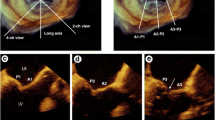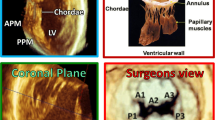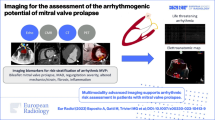Opinion statement
Mitral valve disease (MVD) related to mitral valve prolapse (MVP), coronary artery disease (CAD), and calcific mitral stenosis, is increasing in prevalence across the USA and Europe in the context of a longer life expectancy and aging population. In developing countries, rheumatic heart disease remains a major cause of MVD. Echocardiography represents the primary diagnostic modality for assessment of the mitral valve (MV). With the implementation of three-dimensional imaging, echocardiography has become an indispensable tool to evaluate the morphology, geometry, and function of the MV apparatus in the pre-operative setting. However, recognition of its limitations and advances in newer technologies have led to a growing interest in other imaging modalities such as cardiac magnetic resonance (CMR). Although still not widely available, CMR is an essential complement to echocardiography, especially when poor image quality, significant variability in flow diameter measurements, and geometric assumptions of flow orifice preclude accurate quantification of mitral regurgitation on echocardiographic images. In addition, CMR can reliably provide quantitative determination of ventricular volumes and function, hence facilitating surgical decision-making when serial linear echocardiographic measurements are discrepant. Finally, CMR assessment of fibrosis using late gadolinium enhancement allows better understanding of the interactions between MVD and the myocardium in both MVP and MVD related to CAD or other myopathy. In this review, we summarize the role of the available imaging modalities in understanding valvular pathology and determining severity of regurgitation or stenosis. Recently published valvular guidelines highlight the importance of monitoring MVD progression and the shift to intervention earlier in the course of disease. In this context, we also discuss the potential role of echocardiography and CMR in identifying early stages of MVD and/or pre-clinical markers of myocardial dysfunction.

Similar content being viewed by others
References and Recommended Reading
Papers of particular interest, published recently, have been highlighted as: • Of importance •• Of major importance
Nkomo VT, Gardin JM, Skelton TN, et al. Burden of valvular heart diseases: a population-based study. Lancet. 2006;368:1005–11.
Otto CM. Textbook of clinical echocardiography. 5th ed. Philadelphia: Elsevier/Saunders; 2013. Print. p 247.
Delling FN, Vasan RS. Epidemiology and pathophysiology of mitral valve prolapse: new insights into disease progression, genetics, and molecular basis. Circulation. 2014;129:2158–70.
Freed LA, Levy D, Levine RA, et al. Prevalence and clinical outcome of mitral-valve prolapse. N Engl J Med. 1999;341:1–7.
Delling FN, Gona P, Larson MG, et al. Mild expression of mitral valve prolapse in the Framingham offspring: expanding the phenotypic spectrum. J Am Soc Echocardiogr: Off Publ Am Soc Echocardiogr. 2014;27:17–23. This article discusses the prevalence and echocardiographic characteristics of early, non-diagnostic forms of mitral valve prolapse (MVP) in the general population.
Delling FN, Rong J, Larson MG, et al. Familial clustering of mitral valve prolapse in the community. Circulation. 2015;131:263–8. This manuscript discusses how non-diagnostic MVP morphologies in parents can increase the risk of offspring MVP, thereby demonstrating that these morphologies may have clinical importance.
Hung JW. Ischemic (functional) mitral regurgitation. Cardiol Clin. 2013;31:231–6.
Fornes P, Heudes D, Fuzellier JF, et al. Correlation between clinical and histologic patterns of degenerative mitral valve insufficiency: a histomorphometric study of 130 excised segments. Cardiovasc Pathol: Off J Soc Cardiovasc Pathol. 1999;8:81–92.
Nishimura RA, Otto CM, Bonow RO, et al. 2014 aha/acc guideline for the management of patients with valvular heart disease: a report of the american college of cardiology/american heart association task force on practice guidelines. J Am Coll Cardiol. 2014;63:e57–185. This report from AHA/ACC provides diagnostic and management algorithms for valvular heart disease, and includes updated criteria for the staging and grading of severity of mitral regurgitation (MR) and mitral stenosis (MS).
Delgado V, Tops LF, Schuijf JD, et al. Assessment of mitral valve anatomy and geometry with multislice computed tomography. J Am Coll Cardiol Img. 2009;2:556–65.
Beaudoin J, Thai WE, Wai B, et al. Assessment of mitral valve adaptation with gated cardiac computed tomography: validation with three-dimensional echocardiography and mechanistic insight to functional mitral regurgitation. Circ Cardiovasc Imaging. 2013;6:784–9. This investigation studies CT-based measurements of MV size in patients with functional or secondary MR, and finds the emerging technology of CT to be comparable to 3D echocardiography.
Alkadhi H, Wildermuth S, Bettex DA, et al. Mitral regurgitation: quantification with 16-detector row ct–initial experience. Radiology. 2006;238:454–63.
Guo YK, Yang ZG, Ning G, et al. Isolated mitral regurgitation: quantitative assessment with 64-section multidetector ct–comparison with mr imaging and echocardiography. Radiology. 2009;252:369–76.
Choo WS, Steeds RP. Cardiac imaging in valvular heart disease. Br J Radiol. 2011;84(Spec No 3):S245–57.
Helmcke F, Nanda NC, Hsiung MC, et al. Color doppler assessment of mitral regurgitation with orthogonal planes. Circulation. 1987;75:175–83.
Fehske W, Omran H, Manz M, et al. Color-coded doppler imaging of the vena contracta as a basis for quantification of pure mitral regurgitation. Am J Cardiol. 1994;73:268–74.
Bargiggia GS, Tronconi L, Sahn DJ, et al. A new method for quantitation of mitral regurgitation based on color flow doppler imaging of flow convergence proximal to regurgitant orifice. Circulation. 1991;84:1481–9.
Rivera JM, Vandervoort PM, Thoreau DH, et al. Quantification of mitral regurgitation with the proximal flow convergence method: a clinical study. Am Heart J. 1992;124:1289–96.
Grigioni F, Enriquez-Sarano M, Zehr KJ, et al. Ischemic mitral regurgitation: long-term outcome and prognostic implications with quantitative doppler assessment. Circulation. 2001;103:1759–64.
Sun JP, Yang XS, Qin JX, et al. Quantification of mitral regurgitation by automated cardiac output measurement: experimental and clinical validation. J Am Coll Cardiol. 1998;32:1074–82.
Messika-Zeitoun D, Johnson BD, Nkomo V, et al. Cardiopulmonary exercise testing determination of functional capacity in mitral regurgitation: physiologic and outcome implications. J Am Coll Cardiol. 2006;47:2521–7.
Magne J, Lancellotti P, Pierard LA. Exercise-induced changes in degenerative mitral regurgitation. J Am Coll Cardiol. 2010;56:300–9.
Magne J, Lancellotti P, Pierard LA. Exercise pulmonary hypertension in asymptomatic degenerative mitral regurgitation. Circulation. 2010;122:33–41.
Kusunose K, Popovic ZB, Motoki H, Marwick TH. Prognostic significance of exercise-induced right ventricular dysfunction in asymptomatic degenerative mitral regurgitation. Circ Cardiovasc Imaging. 2013;6:167–76.
Lee R, Haluska B, Leung DY, et al. Functional and prognostic implications of left ventricular contractile reserve in patients with asymptomatic severe mitral regurgitation. Heart. 2005;91:1407–12.
Magne J, Mahjoub H, Dulgheru R, et al. Left ventricular contractile reserve in asymptomatic primary mitral regurgitation. Eur Heart J. 2014;35:1608–16.
Lancellotti P, Gerard PL, Pierard LA. Long-term outcome of patients with heart failure and dynamic functional mitral regurgitation. Eur Heart J. 2005;26:1528–32.
Lancellotti P, Magne J, Dulgheru R, et al. Clinical significance of exercise pulmonary hypertension in secondary mitral regurgitation. The American journal of cardiology. 2015;115:1454–61.
Yosefy C, Hung J, Chua S, et al. Direct measurement of vena contracta area by real-time 3-dimensional echocardiography for assessing severity of mitral regurgitation. Am J Cardiol. 2009;104:978–83.
Zeng X, Levine RA, Hua L, et al. Diagnostic value of vena contracta area in the quantification of mitral regurgitation severity by color doppler 3d echocardiography. Circ Cardiovasc Imaging. 2011;4:506–13.
de Agustin JA, Marcos-Alberca P, Fernandez-Golfin C, et al. Direct measurement of proximal isovelocity surface area by single-beat three-dimensional color doppler echocardiography in mitral regurgitation: a validation study. J Am Soc Echocardiogr: Off Publ Am Soc Echocardiogr. 2012;25:815–23.
Sharma R, Mann J, Drummond L, et al. The evaluation of real-time 3-dimensional transthoracic echocardiography for the preoperative functional assessment of patients with mitral valve prolapse: a comparison with 2-dimensional transesophageal echocardiography. J Am Soc Echocardiogr: Off Publ Am Soc Echocardiogr. 2007;20:934–40.
Altiok E, Hamada S, van Hall S, et al. Comparison of direct planimetry of mitral valve regurgitation orifice area by three-dimensional transesophageal echocardiography to effective regurgitant orifice area obtained by proximal flow convergence method and vena contracta area determined by color doppler echocardiography. Am J Cardiol. 2011;107:452–8.
Shanks M, Siebelink HM, Delgado V, et al. Quantitative assessment of mitral regurgitation: comparison between three-dimensional transesophageal echocardiography and magnetic resonance imaging. Circ Cardiovasc Imaging. 2010;3:694–700.
Han Y, Peters DC, Salton CJ, et al. Cardiovascular magnetic resonance characterization of mitral valve prolapse. J Am Coll Cardiol Img. 2008;1:294–303.
Chinitz JS, Chen D, Goyal P, et al. Mitral apparatus assessment by delayed enhancement cmr: relative impact of infarct distribution on mitral regurgitation. J Am Coll Cardiol Img. 2013;6:220–34. This study of post-myocardial infarction MR demonstrates that CMR is useful for identifying correlations between infarct distribution and severity of MR.
Buchner S, Debl K, Poschenrieder F, et al. Cardiovascular magnetic resonance for direct assessment of anatomic regurgitant orifice in mitral regurgitation. Circ Cardiovasc Imaging. 2008;1:148–55.
Buchner S, Poschenrieder F, Hamer OW, et al. Direct visualization of regurgitant orifice by cmr reveals differential asymmetry according to etiology of mitral regurgitation. J Am Coll Cardiol Img. 2011;4:1088–96.
Kon MW, Myerson SG, Moat NE, Pennell DJ. Quantification of regurgitant fraction in mitral regurgitation by cardiovascular magnetic resonance: comparison of techniques. J Heart Valve Dis. 2004;13:600–7.
Kizilbash AM, Hundley WG, Willett DL, et al. Comparison of quantitative doppler with magnetic resonance imaging for assessment of the severity of mitral regurgitation. Am J Cardiol. 1998;81:792–5.
Gelfand EV, Hughes S, Hauser TH, et al. Severity of mitral and aortic regurgitation as assessed by cardiovascular magnetic resonance: optimizing correlation with doppler echocardiography. J Cardiovasc Magn Reson: Off J Soc Cardiovasc Magn Reson. 2006;8:503–7.
Hundley WG, Li HF, Willard JE, et al. Magnetic resonance imaging assessment of the severity of mitral regurgitation. Comparison with invasive techniques. Circulation. 1995;92:1151–8.
Uretsky S, Gillam L, Lang R, et al. Discordance between echocardiography and mri in the assessment of mitral regurgitation severity: a prospective multicenter trial. J Am Coll Cardiol. 2015;65:1078–88. This study compares CMR imaging with 2D echocardiography and demonstrates the superiority of the newer imaging technique compared to both TTE and TEE for assessment of post-surgical MR severity.
Mahnken AH, Muhlenbruch G, Das M, et al. MDCT detection of mitral valve calcification: prevalence and clinical relevance compared with echocardiography. AJR Am J Roentgenol. 2007;188:1264–9.
Willmann JK, Kobza R, Roos JE, et al. ECG-gated multi-detector row CT for assessment of mitral valve disease: initial experience. Eur Radiol. 2002;12:2662–9.
LaBounty TM, Glasofer S, Devereux RB, et al. Comparison of cardiac computed tomographic angiography to transesophageal echocardiography for evaluation of patients with native valvular heart disease. Am J Cardiol. 2009;104:1421–8.
Messika-Zeitoun D, Serfaty JM, Laissy JP, et al. Assessment of the mitral valve area in patients with mitral stenosis by multislice computed tomography. J Am Coll Cardiol. 2006;48:411–3.
Zeng X, Tan TC, Dudzinski DM, Hung J. Echocardiography of the mitral valve. Prog Cardiovasc Dis. 2014;57:55–73.
Martin RP, Rakowski H, Kleiman JH, et al. Reliability and reproducibility of two dimensional echocardiograph measurement of the stenotic mitral valve orifice area. Am J Cardiol. 1979;43:560–8.
Sugeng L, Weinert L, Lammertin G, et al. Accuracy of mitral valve area measurements using transthoracic rapid freehand 3-dimensional scanning: comparison with noninvasive and invasive methods. J Am Soc Echocardiogr: Off Publ Am Soc Echocardiogr. 2003;16:1292–300.
Zamorano J, Cordeiro P, Sugeng L, et al. Real-time three-dimensional echocardiography for rheumatic mitral valve stenosis evaluation: an accurate and novel approach. J Am Coll Cardiol. 2004;43:2091–6.
Zamorano J, de Agustin JA. Three-dimensional echocardiography for assessment of mitral valve stenosis. Curr Opin Cardiol. 2009;24:415–9.
Binder TM, Rosenhek R, Porenta G, et al. Improved assessment of mitral valve stenosis by volumetric real-time three-dimensional echocardiography. J Am Coll Cardiol. 2000;36:1355–61.
Messika-Zeitoun D, Brochet E, Holmin C, et al. Three-dimensional evaluation of the mitral valve area and commissural opening before and after percutaneous mitral commissurotomy in patients with mitral stenosis. Eur Heart J. 2007;28:72–9.
Chu JW, Levine RA, Chua S, et al. Assessing mitral valve area and orifice geometry in calcific mitral stenosis: a new solution by real-time three-dimensional echocardiography. J Am Soc Echocardiogr: Off Publ Am Soc Echocardiogr. 2008;21:1006–9.
Libanoff AJ, Rodbard S. Atrioventricular pressure half-time. Measure of mitral valve orifice area. Circulation. 1968;38:144–50.
Hatle L, Angelsen B, Tromsdal A. Noninvasive assessment of atrioventricular pressure half-time by doppler ultrasound. Circulation. 1979;60:1096–104.
Voelker W, Regele B, Dittmann H, et al. Effect of heart rate on transmitral flow velocity profile and doppler measurements of mitral valve area in patients with mitral stenosis. Eur Heart J. 1992;13:152–9.
Nakatani S, Masuyama T, Kodama K, et al. Value and limitations of doppler echocardiography in the quantification of stenotic mitral valve area: comparison of the pressure half-time and the continuity equation methods. Circulation. 1988;77:78–85.
Flachskampf FA, Weyman AE, Gillam L, et al. Aortic regurgitation shortens doppler pressure half-time in mitral stenosis: clinical evidence, in vitro simulation and theoretic analysis. J Am Coll Cardiol. 1990;16:396–404.
Thomas JD, Wilkins GT, Choong CY, et al. Inaccuracy of mitral pressure half-time immediately after percutaneous mitral valvotomy. Dependence on transmitral gradient and left atrial and ventricular compliance. Circulation. 1988;78:980–93.
Karp K, Teien D, Bjerle P, Eriksson P. Reassessment of valve area determinations in mitral stenosis by the pressure half-time method: impact of left ventricular stiffness and peak diastolic pressure difference. J Am Coll Cardiol. 1989;13:594–9.
Kawahara T, Yamagishi M, Seo H, et al. Application of doppler color flow imaging to determine valve area in mitral stenosis. J Am Coll Cardiol. 1991;18:85–92.
Rodriguez L, Thomas JD, Monterroso V, et al. Validation of the proximal flow convergence method. Calculation of orifice area in patients with mitral stenosis. Circulation. 1993;88:1157–65.
Rifkin RD, Harper K, Tighe D. Comparison of proximal isovelocity surface area method with pressure half-time and planimetry in evaluation of mitral stenosis. J Am Coll Cardiol. 1995;26:458–65.
Bennis A, Drighil A, Tribouilloy C, et al. Clinical application in routine practice of the proximal flow convergence method to calculate the mitral surface area in mitral valve stenosis. Int J Cardiovasc Imaging. 2002;18:443–51.
Lee TY, Tseng CJ, Chiao CD, et al. Clinical applicability for the assessment of the valvular mitral stenosis severity with doppler echocardiography and the proximal isovelocity surface area (PISA) method. Echocardiography. 2004;21:1–6.
de Agustin JA, Mejia H, Viliani D, et al. Proximal flow convergence method by three-dimensional color doppler echocardiography for mitral valve area assessment in rheumatic mitral stenosis. J Am Soc Echocardiogr: Off Publ Am Soc Echocardiogr. 2014;27:838–45. This study highlights the incremental diagnostic benefit of 3D TTE over 2D TTE for application of the PISA method to mitral valve area calculations, which may allow it to be used more often for clinical assessment of MS.
Nishimura RA, Rihal CS, Tajik AJ, Holmes Jr DR. Accurate measurement of the transmitral gradient in patients with mitral stenosis: a simultaneous catheterization and doppler echocardiographic study. J Am Coll Cardiol. 1994;24:152–8.
Reis G, Motta MS, Barbosa MM, et al. Dobutamine stress echocardiography for noninvasive assessment and risk stratification of patients with rheumatic mitral stenosis. J Am Coll Cardiol. 2004;43:393–401.
Lev EI, Sagie A, Vaturi M, et al. Value of exercise echocardiography in rheumatic mitral stenosis with and without significant mitral regurgitation. Am J Cardiol. 2004;93:1060–3.
Picano E, Pibarot P, Lancellotti P, et al. The emerging role of exercise testing and stress echocardiography in valvular heart disease. J Am Coll Cardiol. 2009;54:2251–60.
Wilkins GT, Weyman AE, Abascal VM, et al. Percutaneous balloon dilatation of the mitral valve: an analysis of echocardiographic variables related to outcome and the mechanism of dilatation. Br Heart J. 1988;60:299–308.
Kronzon I, Tunick PA, Glassman E, et al. Transesophageal echocardiography to detect atrial clots in candidates for percutaneous transseptal mitral balloon valvuloplasty. J Am Coll Cardiol. 1990;16:1320–2.
Schlosshan D, Aggarwal G, Mathur G, et al. Real-time 3d transesophageal echocardiography for the evaluation of rheumatic mitral stenosis. J Am Coll Cardiol Img. 2011;4:580–8.
Min SY, Song JM, Kim YJ, et al. Discrepancy between mitral valve areas measured by two-dimensional planimetry and three-dimensional transoesophageal echocardiography in patients with mitral stenosis. Heart. 2013;99:253–8.
Langerveld J, Valocik G, Plokker HW, et al. Additional value of three-dimensional transesophageal echocardiography for patients with mitral valve stenosis undergoing balloon valvuloplasty. J Am Soc Echocardiogr: Off Publ Am Soc Echocardiogr. 2003;16:841–9.
Applebaum RM, Kasliwal RR, Kanojia A, et al. Utility of three-dimensional echocardiography during balloon mitral valvuloplasty. J Am Coll Cardiol. 1998;32:1405–9.
Heidenreich PA, Steffens J, Fujita N, et al. Evaluation of mitral stenosis with velocity-encoded cine-magnetic resonance imaging. Am J Cardiol. 1995;75:365–9.
Lin SJ, Brown PA, Watkins MP, et al. Quantification of stenotic mitral valve area with magnetic resonance imaging and comparison with doppler ultrasound. J Am Coll Cardiol. 2004;44:133–7.
Djavidani B, Debl K, Lenhart M, et al. Planimetry of mitral valve stenosis by magnetic resonance imaging. J Am Coll Cardiol. 2005;45:2048–53.
Ohyama H, Hosomi N, Takahashi T, et al. Comparison of magnetic resonance imaging and transesophageal echocardiography in detection of thrombus in the left atrial appendage. Stroke; J Cereb Circ. 2003;34:2436–9.
Djavidani B, Debl K, Buchner S, et al. Mri planimetry for diagnosis and follow-up of valve area in mitral stenosis treated with valvuloplasty. RoFo: Fortschr Geb Rontgenstr Nuklearmed. 2006;178:781–6.
Acknowledgments
We thank Dr. Feroze Mahmood for the intra-operative 3D TEE images.
Compliance with Ethics Guidelines
Conflict of Interest
Francesca N. Delling is funded by National Heart, Lung and Blood Institute K23HL116652.
Human and Animal Rights and Informed Consent
This article does not contain any studies with human or animal subjects performed by any of the authors.
Author information
Authors and Affiliations
Corresponding author
Additional information
This article is part of the Topical Collection on Imaging
Electronic Supplementary Material
Below is the link to the electronic supplementary material.
Video 1
Example of rheumatic mitral stenosis shown in a 2D TTE parasternal long-axis view. Both mitral leaflets are thickened and deformed, with a characteristic “hockey stick” appearance of the anterior leaflet as a result of diastolic leaflet doming, and poor excursion of the posterior leaflet. The narrowest orifice occurs at the leaflet tips, while the mitral valve annulus is not affected. 2D = 2-dimensional; TTE = transthoracic echocardiogram. (AVI 8,492 kb)
Video 2
A 3D TEE en face view of the mitral valve from the left atrial perspective, demonstrating prominent fusion of the lateral commissure and preserved A3 and P3 mobility. 3D = 3-dimensional; TEE = transesophageal echocardiogram. (MOV 329 kb)
Rights and permissions
About this article
Cite this article
Motiwala, S.R., Delling, F.N. Assessment of Mitral Valve Disease: A Review of Imaging Modalities. Curr Treat Options Cardio Med 17, 30 (2015). https://doi.org/10.1007/s11936-015-0390-1
Published:
DOI: https://doi.org/10.1007/s11936-015-0390-1




